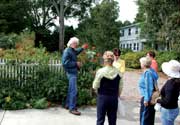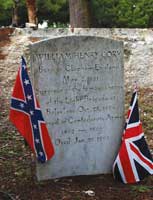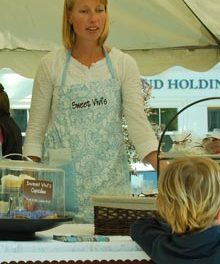MARK SHAFFER strolls through five centuries of Beaufort history with tour guide extraordinaire, JON SHARP
Timing is everything

“Is this your retirement job?”
The tall man with the full mane of white hair takes no time to ponder the question.
“Yes, it is.”
The woman nods, “Sweet,” she says.
Jon Sharp smiles, a piece of silver and turquoise the size of a teaspoon dangles from his left ear. He welcomes a group of women from West Virginia day-tripping up from Hilton Head. Three or four locals and a couple from Michigan round out this morning’s tour. Charming and charismatic, in another time, in this same place, Jon might easily pass for a pirate or a privateer, ironic considering how he practically washed up on these shores.
The tour group begins to form up in the parking lot of the Beaufort City Marina, beneath an uncertain sky of rolling grey clouds. The famous and influential breezes off the Beaufort River have given way to autumn’s full bluster. The river is choppy and smells of the sea. There is drama in the wind.
“I set sail out into the Atlantic in winter time, alone, never having sailed a day before in my life.” This is not a line from a lesser known work by Robert Louis Stevenson . This is the beginning of Jon’s own story, one that might fit neatly into the running narrative he delivers each day to groups like this along a 2 mile trek through 500 years of Beaufort history. It sounds like a classic adventure tail: a man tires of the glamorous life in a big city, sells off his possessions and sets off across the country on a quest for some sort of inner fulfillment. In this story the big city is Hollywood where Jon directed television shows like “Archie Bunker’s Place” and “The Golden Girls.” Later he caught the acting bug and moved in front of the camera for guest shots on shows like “Dynasty” and “Hunter.” But by the early 1990’s he was burned out on Hollywood and facing one of life’s major milestones.
“I turned 50,” Jon explains, “and the thought suddenly crossed my mind that a whole lot more of my life now was behind me than lay ahead of me. So, when I was a kid in school I’d read a book called Kon-Tiki by Thor Heyerdahl , and apparently that was just sitting back there someplace and all of a sudden it just burst into flames. The next thing I knew I sold the house, sold the car, sold the art, bought a little pickup and spent a month driving across America.” And so, he ends up in Beaufort – the one pronounced Bo-fort – Beaufort, North Carolina. There he purchases a venerable sailing vessel of 35 feet and shoves off into the unknown.
Forward into the past
By the time the tour rambles out of the Marina, turns up Newcastle and into the churchyard of St. Helena Episcopal, nearly 200 years have passed. The Spanish have come and gone. The French – led by the intrepid Jean Ribaut – have left their mark and names behind. Ribaut and most of his men have also left their heads in Florida to Spanish axes after his fleet is shipwrecked by a hurricane . “Timing is everything in history,” Jon informs us.
 Now come the English. By 1711 the town of Beaufort (SC) is established and the Parish of St. Helena is founded a year later. By 1715 the town is just beginning to flourish when the Yemassee – fed up with two hundred years of European abuse – burn it to the ground and massacre dozens of settlers. Nine years later St. Helena’s is built and remains one of the oldest active churches in America. Among her parishioners is Thomas Heyward, who lent his “John Hancock,” along with the John Hancock, to the Declaration of Independence. The graves bear the names of some of the most influential families of the Old South. Over time the names of the Stuarts, Barnwells, Draytons, Rhetts and more begin to co-mingle on the headstones.
Now come the English. By 1711 the town of Beaufort (SC) is established and the Parish of St. Helena is founded a year later. By 1715 the town is just beginning to flourish when the Yemassee – fed up with two hundred years of European abuse – burn it to the ground and massacre dozens of settlers. Nine years later St. Helena’s is built and remains one of the oldest active churches in America. Among her parishioners is Thomas Heyward, who lent his “John Hancock,” along with the John Hancock, to the Declaration of Independence. The graves bear the names of some of the most influential families of the Old South. Over time the names of the Stuarts, Barnwells, Draytons, Rhetts and more begin to co-mingle on the headstones.
Jon points out the grave of one William Henry Cory who, as a British Cavalryman, survived the infamous Charge of the Light Brigade immortalized by Tennyson. He later immigrated to South Carolina and served as a Confederate officer during the Civil War. The headstone is flanked on either side by a Union Jack and a Battle Flag stuck into the earth. Dozens of Battle Flags flutter among a lesser number of Stars and Stripes and a few more Union Jacks, vivid symbols of clashing ideologies all ironically clad in red, white and blue among the sorrowfully grey picturesque monuments. 
At the front of the church Jon confiscates cameras and takes shots of everyone who wants the moment captured. There will be many such photo-ops along the way.
Meanwhile, back on the boat…
“February 16th, 1992, I set sail out into the Atlantic in winter time, alone, never having sailed a day before in my life.” So begins Jon’s personal narrative. “But I had read a book on sailing during my trip and one of the chapters I’d read was about “reefing” so I reefed her down before I left – and thank God I did – because I cleared the first couple of ocean waves and found that I was deathly prone to sea sickness. I mean face down in the cockpit praying for death.”
Timing is everything.
On his maiden voyage Jon’s sailed into a mild nor’easter with winds of 35 to 40 knots, dicey work for an experienced sailor on his own, a potentially deadly situation for a complete greenhorn. Twenty-four hours later, suffering from exposure and dehydration, the grim reality of his folly is all too apparent. “I managed to struggle down to the radio and put out a distress call,” he remembers, “and here comes the Coast Guard in a little red helicopter . They lower a basket, I rolled myself into it and they drop me down in the parking lot of a hospital and as I read the sign, I let out a great moan of dismay and the rescue swimmer wanted to know what the problem was now? And I said ‘I’ve been sailing around in a damn circle. I’m right back in Bo-fort. And he said, ‘nope, nope, you in Be-you-fort, now.” He chuckles at the irony.
The Grand Meander
It’s important to point out that Jon Sharp could recite a parking ticket and make it sound like Ivanhoe . We are spellbound in his narrative, following along like pilgrims in the wake of this constant, animated flow of information. We wander through the centuries, in and out of wars and plagues, fires and hurricanes. Cars honk, people wave – the proper use of an automobile horn in the south.
Down Church Street we pass the middle of the eighteenth century as vast fortunes are forged from rice and indigo, borne on the backs of slaves. The finer lines of Beaufort’s character are cut again and again by the chisel and hammer of war. The American Revolution’s impact is felt more cruelly in South Carolina than in any of the other newly declared independent colonies. The land is split, families divided between Tories and Patriots, brother against brother, father against son.
Back onto Bay Street and the rise of King Cotton. Beaufort boasts more millionaires per capita than any other American town. It sits at the social epicenter of hundreds of plantations – nearly 900 by the outbreak of the Civil War – powered by the labor of thirty thousand slaves. Most of these huge magnificent homes were summer cottages for the planters and their families, built to exploit the natural air conditioning from the river breezes.
Castaway
 The romance of his situation is not altogether lost on Jon; it just takes a while to sink in. For the first year or so he lives on the boat (towed in compliments of the coast Guard), and gets by as he can, fully intending to one day resume his quest.
The romance of his situation is not altogether lost on Jon; it just takes a while to sink in. For the first year or so he lives on the boat (towed in compliments of the coast Guard), and gets by as he can, fully intending to one day resume his quest.
“The years went by and the years went by and all of a sudden I’m coming up to my 63rd birthday. I’d married a woman I’d met here, living out in her house and just as my birthday approaches I realized I hadn’t been down on that sailboat in three months. And you just can’t do that to a wooden boat.” The funny thing about epiphany is you almost never see it coming. “All of a sudden I realized it was time to let her go.”
Jon spent a year looking for the right buyer, finally selling her to a Gloucester, Massachusetts Boatwright,another chapter in the adventure complete.
“You know, when I first got here all I knew how to do was act and direct,” says Jon. “There wasn’t a whole lot of call for that here in this little town.” Naturally, like any artist faced with a lack of want or need, he remained undeterred. “But I started a theater and for five years I worked at the theater putting on plays, teaching locals how to act.” Eventually the implacable economics of the local theater scene forced a change. “I became a roofing assistant, carrying shingles up to roofs.” He shakes that mass of white hair at the memory. “That got old in a hurry, you know? Then I learned to scuba dive and for a couple of years I made a living diving and scraping the bottoms of boats and unwrapping nets from the propellers of the big shrimp boats, and that was fun. And exciting.” He pauses a beat. “But you get into your sixties, it gets – you know – kind of hard. So I began casting about.”
When it comes to casting about, there’s no better place to do it than in a shrimping town.
“I’m betting he’s done theater or something,” says Dave from Michigan.
Indeed, a buzz has begun to build through the group as Jon leads, us Moses-like, across Carteret, stopping traffic, offering to sacrifice himself as “my honor-bound duty.” Along this grand meander we’ve marched through the Great Skedaddle as the white population of Beaufort flees before advancing Union Troops in 1861. “All but one,” says Jon, “and they found him dead-drunk on the docks.”
Beaufort is never the same. The town remains occupied for the course of the war. Many of the great houses are converted to hospitals. Few of the original occupants will ever return and most of the properties are sold for pennies on the dollar during a Union tax sale. Some are bought by former slaves including Robert Smalls, Beaufort’s most famous son. A legendary Union hero and groundbreaking politician, Smalls is born a slave behind the McKee house in 1839 and dies on the front steps, its master in 1915.
Jon tears up as he recounts the tale of how Smalls took in the widow of his former owner and cared for her until her dying day.
New eyes
So often we wonder over, around and through the obvious for years and years, oblivious to what we’ve come to take for granted or just plain never noticed in the first place. Then one day epiphany rushes out of the blue to smack you around a little and things change. So it was with Jon Sharp, and soon the next chapter in his adventure was writing itself. The self-described “lifelong history geek” dug into the local library researching everything he could about Beaufort and the Sea Islands, eventually landing a job on one of the carriage tours.
“The problem was that tour takes about 45 minutes,” he recalls, “and I’m leaving out gobs of history. And then one day I had the idea, gee whiz, that to walk the same route would take twice as long. I could tell twice as much history. So I started my own little tour business.” Kismet. “Perfect,” he smiles. “Just perfect.”
So, does walking through the past ever get dull?
“All these ladies were new on the tour today, and you could see them. They were just oohing and aahing and that’s what keeps it fresh for me, just looking at their faces and seeing it again and again through new eyes.”
Before Jon winds us back toward Bay Street, there is a “refreshment stop” at The Chocolate Tree, Beaufort’s answer to Godiva. In between bathroom breaks, everyone gets a complimentary chocolate sand dollar. Nearly everyone leaves with an additional bag or box. The woman handing out samples behind the counter asks Jon “how you doin’ today?”
He beams, “Wandering around Beaufort with a great big smile on my face, what could be better?”
Not much.
To book a tour, call Jon at (843) 575-5775 or visit jonswalkinghistory.com. Please send feedback and story suggestions to Mark Shaffer via backyardtourist@gmail.com








